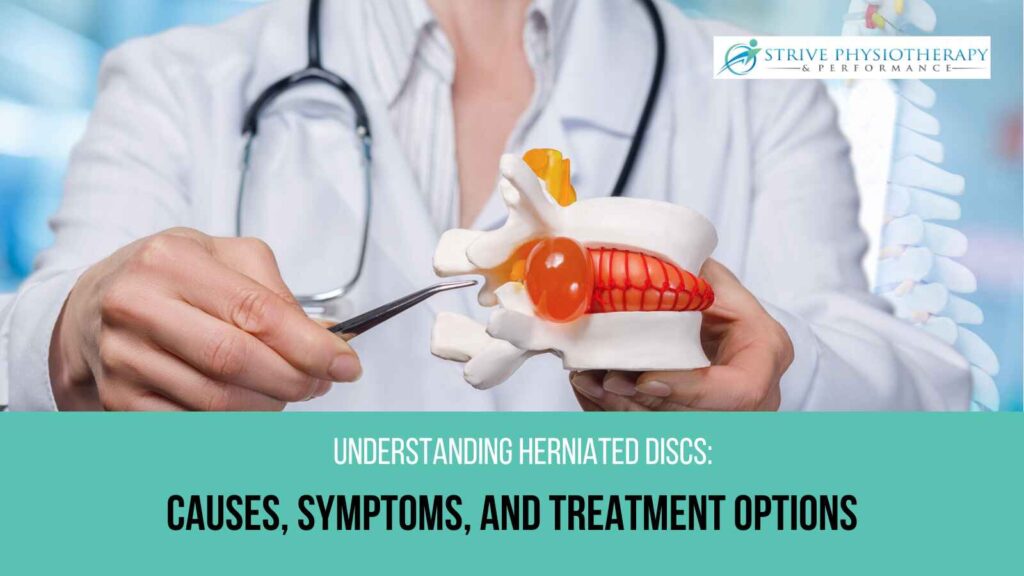
Have you ever heard someone talk about their “slipped disc”, and wonder how on earth a part of your spine can seemingly “slip” out of place? The truth is – it doesn’t! What they actually mean is they have a herniated disc.
What Is a Herniated Disc?
Our spine is made up of 24 smaller bones called vertebrae. In between each of these vertebrae, we have a disc-shaped structure called an intervertebral disc. These discs are designed to transmit forces, or loads, up and down the spine to resist compression, torsion, or shearing forces on the low back.
Each disc has 2 main components: an outer ring called the annulus fibrosis, which encircles a structure called the nucleus pulposus. The outer ring is made up of lots of collagen and some water which makes it sturdy and able to contain the nucleus pulposus which has a higher water content making it less dense.
The outer ring is thickest in the front and sides, but is thinner in the back – this is why most disc herniations protrude backwards. A common myth is that our disc “slips” out of place, however, this is not correct. A disc herniation is when we get a disruption in the outer ring, and the center can start sequestering out of where it’s supposed to be.
This usually happens from repetitive heavy lifting, bending and/or twisting as this increases pressure on the disc. Depending on the degree of movement of the pulposus, we can start to get compression of the nerves that exit our spine. This is why sometimes we get sensations like numbness, tingling, or burning down our leg.
Can Herniated Disc Be Treated by Physiotherapy?
Physiotherapy can absolutely treat a herniated disc! Research has demonstrated that conservative treatment, such as physiotherapy, is an effective treatment for disc herniation.
What Is the Best Therapy for a Herniated Disc?
Movement has great benefits for a herniated disc. This might look different for every individual which is why your physiotherapist will work with you to find movements that are more comfortable or even relieving for your pain and then design a home exercises program based on this.
Usually, bending backwards (spinal extension) tends to be a relieving movement for someone with a disc herniation. This is why you will often see physiotherapists prescribing cobra poses (sometimes called sloppy push-ups).
As you become comfortable with movement, your physiotherapist will progress the level of challenge until you have reached your goals of physiotherapy. Your physiotherapist may also use other tools such as heat, TENS, and acupuncture to help manage pain levels.
Is Physiotherapy Good for L4 L5 Disc Bulge?
Yes! This is one of the most common locations of disc injury along with L5/S1.
Should You Massage a Herniated Disc?
Massage can be a helpful tool to help manage the pain and muscular tension in the lower back. As long as we are mindful of the intensity of the massage so we don’t irritate the nerves in the area, then massage can be appropriate and helpful.
What Not To Do With a Herniated Disc?
Oftentimes, bending forward is the most provocative movement for someone with a herniated disc. This is why we try to limit this movement and any heavy lifting for the first little while to let the pain calm down. This isn’t forever though!
Our bodies are resilient and we are designed to bend! So as pain resolves and function improves, your physiotherapist will work with you to expose your body to movements that flex your spine like bringing your knees to your chest or reaching towards your toes in a sitting or standing position.
When Should I Start Physical Therapy for a Herniated Disc?
There is no wrong or right time to start physiotherapy with a herniated disc. Generally, the sooner the better to avoid the progression of the herniation or nerve involvement. Depending on the person, if the pain is quite high at the beginning and there is no relief with the tools we utilize in physiotherapy, collaborating with your family doctor may be necessary to help get pain levels manageable to allow for us to start moving.
Strive Physiotherapy can help you with many common conditions including:
- Neck Pain
- Chronic pain relief
- Leg pain
- Sports injuries
- Poor posture
Conclusion
We’ve seen firsthand the amazing results that our clients achieve with the help of our clinic. From herniated discs to spinal surgery, our patients have transformed their lives through physiotherapy. Don’t wait any longer to experience these results for yourself. Book your appointment now.